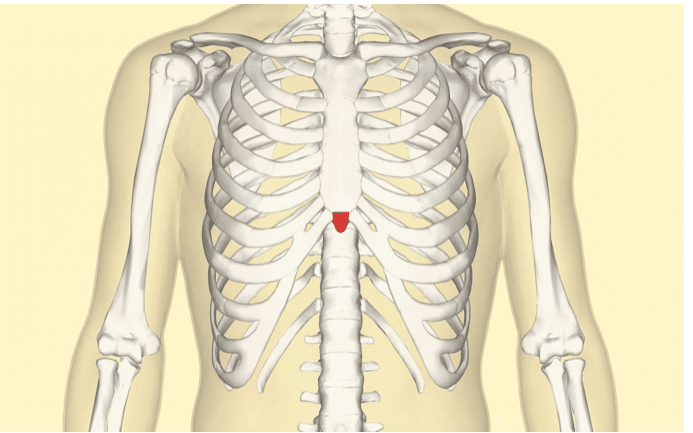The name xiphoid derives from the Greek word for “straight sword” as the structure has a sharp tip, resembling a sword. It is also known by other names including the metasternum, xiphisternum, and xiphoid cartilage.
In this article, we discuss symptoms, causes, and treatment options for xiphoid process pain.
Fast facts about the xiphoid process:
- Pain in the xiphoid process is described as tightness in the lower sternum (breastbone).
- Medically speaking, this pain is called xiphoid syndrome or xiphodynia.
- The xiphoid process can typically heal itself of minor damage with little intervention.
What is the xiphoid process?

This diagram shows the xiphoid process in red.
Image credit: Anatomography, November 3, 2012
The xiphoid process is a tiny bone structure located at the center of the chest, just below the lower part of the sternum.
At birth, the xiphoid process is formed from cartilage that eventually develops into bone.
During a person’s early life, the xiphoid process rarely causes any discomfort given its soft cartilage structure. However, as it hardens, it can cause some discomfort in later life for many reasons.
Symptoms of xiphoid process pain
Discomfort can range from mild to severe. A person may feel pain in muscle groups connected to the xiphoid process around the abdomen and chest.
Symptoms tend to come and go, making it a challenge to diagnose. It is also possible for the area to become inflamed, causing a lump to develop around the lower sternum.
This lump is a result of inflammation but can often be mistaken for a more serious medical condition, such as a tumor.
Causes of xiphoid process pain

Lifting heavy objects may cause xiphoid process pain.
A common cause of xiphoid process pain is acute chest trauma that has damaged the structure.
The xiphoid process is not protected or supported by surrounding structures, making it vulnerable to damage. This damage can occur during cardiopulmonary resuscitation (CPR) when a person applies too much pressure to the lower sternum.
How many pounds have you lost this month? At Dieta Efectiva you can lose 10-12 lbs your first week and 2 – 5 lbs every week after. Visit us dietaefectiva.net to learn more about our program
BG:NMT







